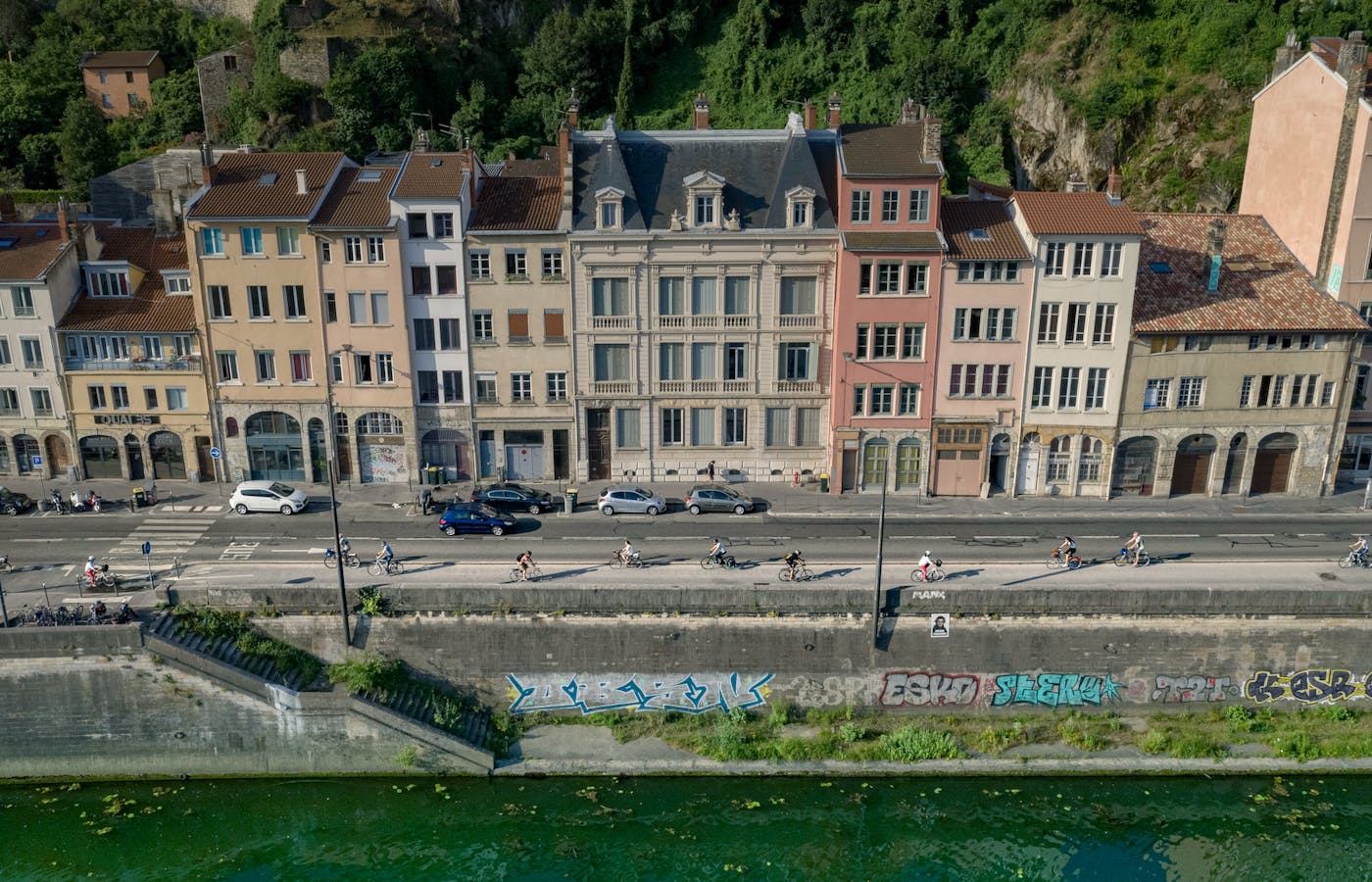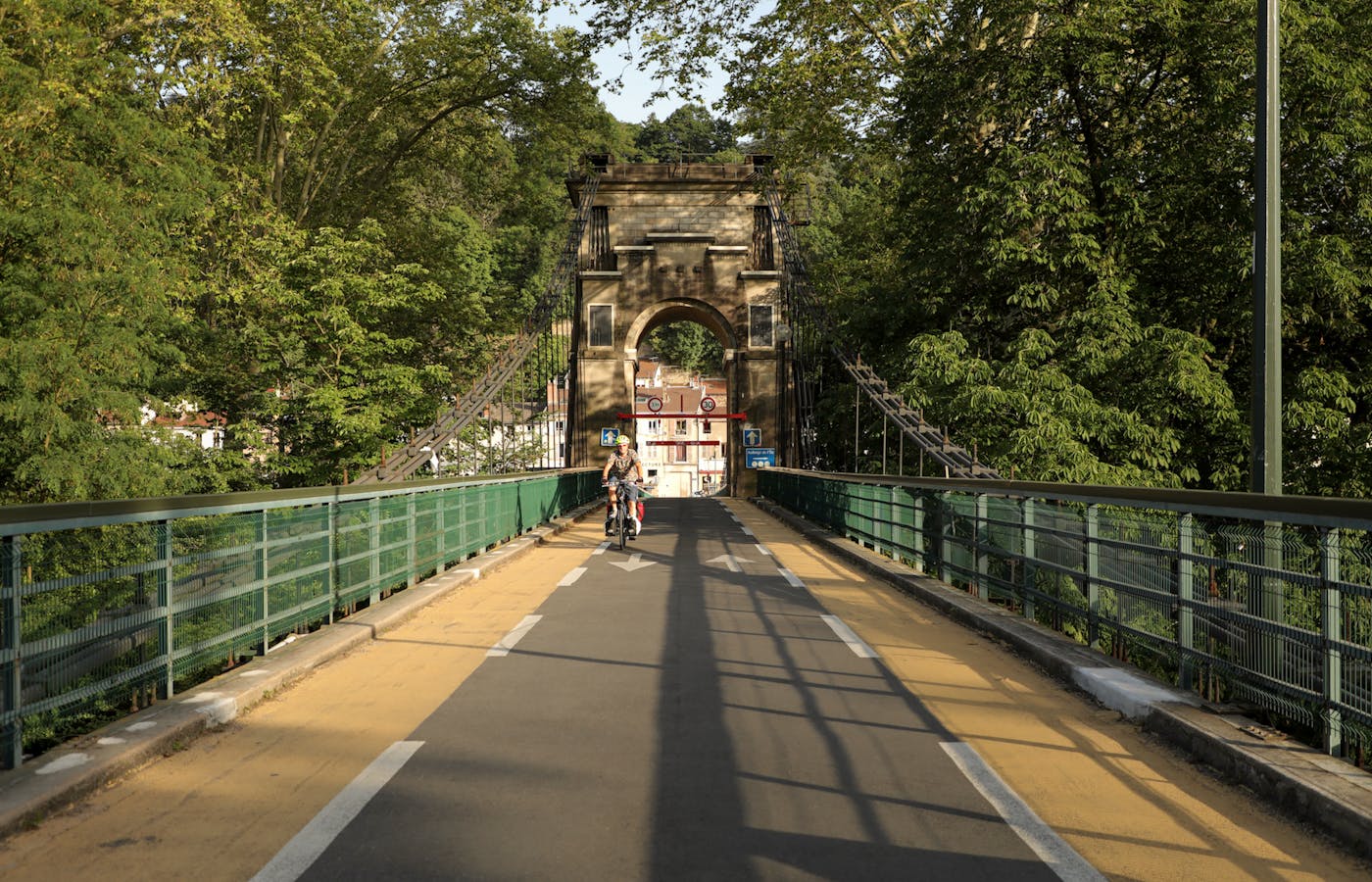What It’s Like To Ride in a Top-Rated Bike City
By: Mark Douglas Wessel, contributing writer

Lyon, France, which consistently ranks among the best cities for bicycling in PeopleForBikes’ annual City Ratings list, is still working hard to improve bicycling locally.
This past September, as I biked the streets of Lyon, France, I was struck by the signs and signals catering to cyclists. From the small, dedicated bike traffic lights alternating between red and green to a sign indicating that bikes could turn right on a red or even go straight at an intersection, the roads were easy to navigate, even for a foreigner. This dedication to the bicycle has paid off: Yet another sign broadcasts the fact that more than 28 million bike trips have been made so far this year.
My time in Lyon was reminiscent of similar experiences I’ve had in well-known cycling cities such as Copenhagen, Amsterdam, Utrecht, and Antwerp. The city, situated close to the Swiss border and home to just over half a million people, ranks high in PeopleForBikes’ City Ratings with a score of 81 for 2023. A high score (anything from 80-100) indicates that most common destinations are accessible by safe, comfortable bike routes that serve people of all ages and abilities.
It’s one thing to see a network map and read about what makes a city great for bicycling, and quite another to experience it firsthand.
In Lyon, there’s an abundance of protected bike lanes — separated both from cars and pedestrians — that can accommodate two-way traffic. Greater Métropole de Lyon, which is comprised of 59 municipalities, currently has 1,200 km (745 miles) of cycling facilities, of which 450 km (279 miles) are separated from traffic. Included in that mix is the impressive 1.75 km (1 mile) Crois Rousse multi-modal tunnel built in 2009, which includes a dedicated lane for buses, a sidewalk for pedestrians, and a 3-meter wide bi-directional bike lane, with barriers separating all three.

Photo credit: Guillaume Robert-Famy
All of this from humble beginnings, considering that for most of the 20th century, Lyon was a car-centric city. In the 1970s, the first of the city’s bike infrastructure went in, advancing at no more than a trickle until the early aughts, when progress began to noticeably ramp up. By 2005, Lyon launched its bike share system, Velo’v, and began building more bike infrastructure for people to safely use it. Lyon also curbed driving by instituting low-emissions zones, which restrict vehicles according to the city’s air pollution levels, since 2016.
Today, Lyon’s bike lane network continues to grow, thanks in large part to an ambitious $290 million program known as Les Voies Lyonnaises (“The Lyon Routes”), which on completion will consist of 12 bike roads spanning 250 km (155 miles). The overarching goal of this network is to connect Lyon’s downtown core with its satellite, suburban communities to the north, south, east, and west, making it safer and more convenient for both commuters and leisure travelers from outlying areas to get into the city safely by bike.
As shared by Arthur Bajula, the cycle and pedestrian planning officer for Métropole de Lyon, the city currently has roughly six miles of the new Lyon Routes network built. “We plan to have a third of the project — 90 km or 55 miles — completed or under construction by the summer of 2024,” says Bajula, noting that the network also plays a role in the city’s ongoing efforts to reduce air pollution. “The idea is to strengthen alternative mobility options such as cycling… and to promote cleaner vehicles within low emission zones.”
These numbers point to something of a hockey stick model, with a slow beginning which then ramps up. This echoes the trajectory of the Green Party, which came to power in Lyon in 2020 and has dedicated much of its early years to laying the groundwork for substantial climate work. This includes goals such as reducing C02 emissions by 40%, creating thousands of new ‘green jobs,’ and securing Lyon’s place among the world’s top bike cities.
Unsurprisingly, part of the delay can also be attributed to a handful of car-centric mayors from other Métropole de Lyon municipalities who have sought to slow down the city’s two-wheel transition.
“There’s a lot of political opposition by certain mayors who are not green,” says Pamela Vennin, project manager with Lyon’s International Relations Department, explaining that the mentality is that citizens need cars to maintain their lifestyles and rights to privacy. “They don't want the cars to have problems.”
Still, in the face of vocal opposition, the Green Party has continued to push ahead, choosing to take space from cars by instituting “road diets” — slashing four or six-lane roads with parking on each side of the street to one or two lanes, with no parking, a bike lane, and wider sidewalks.
“Some citizens have been pushing back,” says Vennin. “But it's the political will to tackle global warming, starting with mobility.”
Despite some pushback, all signs point to the Lyonnais embracing bicycling. Within the highest traffic areas of the downtown core, protected bike lanes are commonplace. So much so that you need to make a mental note when walking about to always look both ways for bikes when crossing the street. Even in outlying areas where traffic is lighter and there’s less of a need for protected bike lanes, painted lanes with sharrows on shared streets are the norm.
Last year, 72 bike counters tallied more than 42 million trips in Lyon, reflecting the fact that over the past decade biking trips have grown by 10-15% annually. Since COVID, the pace has picked up with 15-20% year-over-year growth. Overall, bicycling has increased by an incredible 370% since 2013.
With so many cyclists, the city is also working to actively expand its bike parking infrastructure. In 2020, Lyon had 15,000 bike racks and according to Bajulaz, the goal is to quadruple the number of bike racks to 60,000 by 2026. For secure parking, such as bike garages, the goal is to increase the number of spaces tenfold, from 1,500 in 2020 to 15,000 by 2026.
Photo credit: J.Leone
In addition to the expanding network of bike lanes and places to park, other initiatives have helped pave the way for more widespread bike adoption. For instance, the Velo’v bike share program has been a tremendous success, with 422 stations serving 22 of Greater Lyon’s municipalities and more than 10 million rentals in 2022. In my time there, stations were prevalent and obviously well-used by both tourists and locals alike. Shared micromobility becomes even more critical when you consider that one in three residents doesn’t even own a car — a statistic underscored by the fact many locals use Velo’v for commuting.
Lyon is also making an effort to remove financial barriers to mode shift through its bike purchasing program, whereby any city resident is eligible for a grant of up to 1,000 Euro (about $1,053) towards purchasing an e-bike, a cargo bike, a folding bike, or an adaptive bike. The city also loans some 10,000 bikes, many of them reconditioned, to students or young adults seeking jobs between the ages of 18 and 25 through its Free Velo’v program. Most unique perhaps, is Lyon’s Les Auteliers de l’Audace, a bicycle repair training and resale program that recruits residents without a job as a way to help them reintegrate into society.
City officials are also working to make it easier for residents to take their bikes on public transit. “It is now possible to bring your bicycle on trams outside of peak hours,” says Bajulaz, adding that bikes are also allowed on the metro, funiculars, and trains. “We are also experimenting with bringing bikes on certain buses.”
Lyon’s civic leaders remain cognizant of everyday challenges that intersect with the city’s biking experience, ranging from getting more residents on board and comfortable with biking to discouraging drivers from parking or driving on road space dedicated to bikes. Or, as I experienced firsthand during my tour, the prevalence of bikers riding too fast or aggressively, which impacts the safety of both pedestrians and other cyclists.

Photo credit: Guillaume Robert-Famy
Still, compared to most North American cities, Lyon is an exemplary place for bicycling. With a solid network already in place and a population that’s already attained critical mass, the city’s key players are thinking bigger. The planner Bajulaz continues to draw inspiration from other top cities while Lyon Mayor Grégory Doucet is aiming for a city that is “100% walking and cycling.”
The other challenge and opportunity is that, with just three years left in their term, the city’s ruling Green Party feels a sense of urgency to get as much biking infrastructure built as possible before the next election. The concern is that if they don’t win, opposition parties will be less willing to continue advancing the substantial cycling work already underway, or, possibly, to begin prioritizing drivers.
For now, that outcome is hard to imagine. Biking through Lyon’s streets, some of which have been around since Roman times, one feels as if they’ve landed on the right side of history. Everywhere you turn, there are people on bikes as well as clusters of bikes parked adjacent to where residents work and play. Increasingly, there are streets with few, if any, cars.
Mark Douglas Wessel is an urban journalist and communications consultant whose writing focuses on what we can do to create a more sustainable, more liveable world. For more of his work, go to: www.markdouglaswessel.com
Related Topics:

